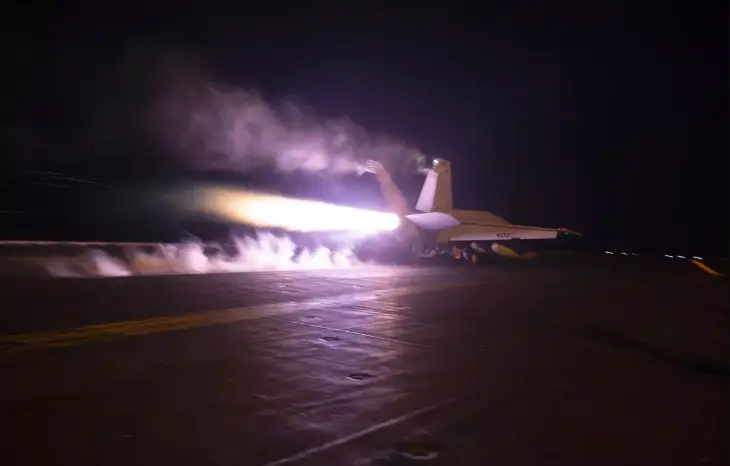The United States and United Kingdom struck 36 Houthi targets in Yemen on Saturday, in a second wave of operations to further incapacitate the Iranian-backed groups that have relentlessly attacked U.S. and international interests in the wake of the Israel-Hamas war. However, Washington again avoided direct strikes on Iran, in an effort to strike a balance between a forceful response and escalating the conflict.
U.S. Central Command reported another strike Sunday “in self-defense against a Houthi anti-ship cruise missile prepared to launch against ships in the Red Sea,” according to a posting on X, formerly Twitter.
“U.S. forces identified the cruise missile in Houthi-controlled areas of Yemen and determined it posed an imminent threat to U.S. Navy ships and merchant vessels in the region. This action will protect freedom of navigation and make international waters safer for U.S. Navy ships and merchant vessels,” the text added.
Saturday’s strikes against the Houthis were launched by U.S. warships and British and U.S. fighter jets. They followed a bombing in Iraq and Syria on Friday that targeted other Iranian-backed militias and the Iranian Revolutionary Guard in retaliation for the drone strike that claimed the lives of three U.S. soldiers in Jordan last weekend.
The Houthi targets were in 13 different locations and were attacked by U.S. F/A-18 fighter jets from the aircraft carrier USS Dwight D. Eisenhower and by the Navy destroyers USS Gravely and USS Carney firing Tomahawk missiles from the Red Sea, U.S. officials told The Associated Press. They were not authorized to speak publicly about the military operation and spoke on condition of anonymity.
The United States warned that its response after the deaths of the soldiers at the Tower 22 base in Jordan last Sunday would not be limited to one night, one target or one group. But the Houthis have carried out almost daily missile or drone attacks on commercial and military vessels transiting the Red Sea and Gulf of Aden and have made clear they have no intention of de-escalating their campaign. At the moment it is unclear whether allied attacks will deter them.
Defense Secretary Lloyd Austin said in a statement that the military action, supported by Australia, Bahrain, Canada, Denmark, the Netherlands and New Zealand, “sends a clear message to the Houthis that they will continue to deal with the consequences if they do not stop their illegal attacks on international warships and shipping vessels.”
“We will not hesitate to defend lives and the free flow of commerce on one of the world’s most crucial waterways,” he added.
The Defense Department said the strikes targeted sites related to subway Houthi weapons storage facilities, missile systems and launchers, air defense systems and radars.
Saturday’s strikes marked the third time the U.S. and U.K. have conducted a large-scale joint operation against Houthi missile launchers, radar sites and drones. The strikes in Yemen are intended to make clear to Iran that Washington holds Tehran responsible for arming, funding and training the militias behind attacks across the Middle East against U.S. and international interests in recent months, including in Iraq and Syria, perpetrated by rebels in Yemen.
A video shared online by people in Sana’a, Yemen’s capital, included the sound of explosions and showed at least one explosion lighting up the night sky. Residents described the explosions as occurring around buildings associated with the Yemeni presidential compound. The Houthi-controlled state-run SABA news agency reported attacks in al-Bayda, Dhamar, Hajjah, Hodeida, Taiz and Sana’a governorates.
On Friday, the U.S. destroyer Laboon and F/A-18 fighter jets from the Eisenhower shot down seven drones launched from Houthi-controlled areas of Yemen into the Red Sea, the destroyer Carney shot down a drone fired in the Gulf of Aden, and U.S. forces took out four more drones that were ready to take off.
Hours before the most recent joint operation, the U.S. conducted another self-defense strike at a site in Yemen, destroying six anti-ship cruise missiles, as it has repeatedly done when it has detected a missile or drone ready to launch.
The Houthi attacks have led shipping companies to divert their vessels from the Red Sea, sending them around Africa via the Cape of Good Hope, a much longer, costlier and less efficient route. The threats have also prompted the United States and its allies to establish a joint mission where warships from participating nations provide a protective air defense umbrella for ships as they travel the important waterway from the Suez Canal to the Bab el-Mandeb Strait.
During normal operations, about 400 commercial vessels transit the southern Red Sea at any given time.

